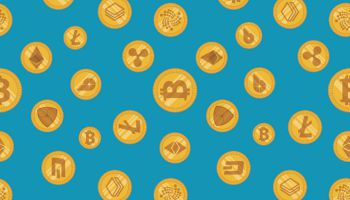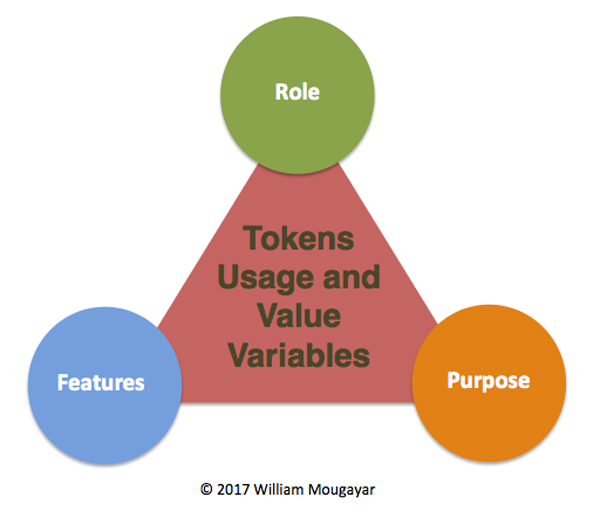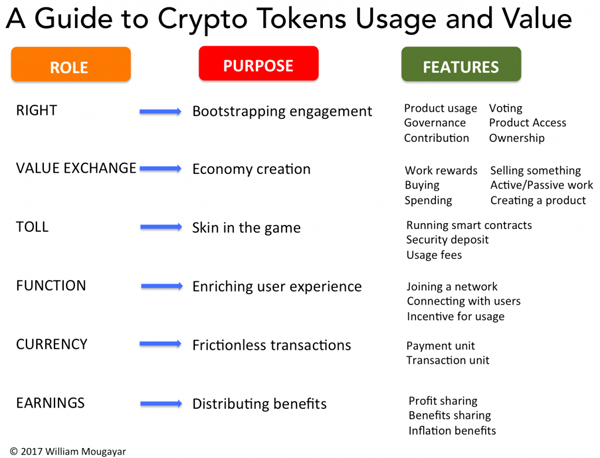Tokenomics
A business guide to token usage, utility, and value
- |
- Written by William Mougayar
- |
- Comments: DISQUS_COMMENTS
 Bitcoin, Ether, or any of the other digital currencies have one thing in common. They are the foundation of their own mini-economies.
Bitcoin, Ether, or any of the other digital currencies have one thing in common. They are the foundation of their own mini-economies.
Despite the incredible amount of attention and material written about cryptocurrency tokens, there hasn’t been a good mainstream definition of what they are.
In the technical realm of the blockchain, the concept of a cryptocurrency token is well understood. It represents a programmable currency unit that is bolted to a blockchain, and is part of smart contract logic in the context of a specific software application.
But in the non-technical arena, what is a token, really?
Privately issued money
A token is just another term for a type of privately issued currency. Traditionally, sovereign governments issued currency and set its terms and governance. In essence they were directing how our economy works with money as the exchange medium for value.
With the blockchain, we now have new types of organizations (and soon, more of the existing type) who are issuing their own currency in the form of digital money as cryptocurrency. They are setting their own terms and rules around its operations, in essence creating new self-sustainable mini-economies.
What was the purview of governments is now in the hands of the many.
In the business realm, we can define the token as:
“A unit of value that an organization creates to self-govern its business model, and empower its users to interact with its products, while facilitating the distribution and sharing of rewards and benefits to all of its stakeholders.”
The Achilles heel of token-based models will be how they are concocted to interact with the business model that underlies them. However, much of the attention has been on designing ICOs (Initial Coin Offerings, how a cryptocurrency begins) to optimize for cryptoeconomics, a term that has come to describe the mechanics and specifics of token distribution, according to a given sale and ownership structure.
Going forward, the token usage relationships will be far more important than the design of its underlying cryptoeconomics. As a recent article by blockchain attorney Reuben Bramanathan aptly points out, there is no perfect token sale structure. You can precisely engineer an ICO and that will get you to launch it properly, but then you still need to deliver a viable business model for the long term.
Getting a token off the ground
In early 2015, I explained (yes, it was quite early) token usages in the context of a Distributed Autonomous Organization Operational Framework, and I summarized a few usage models including the rights, rewards, and work models that are being practiced now. Much of what I wrote then applies today, even more so, especially this part:
“The key objective of a DAO is value creation or production, and to make that happen, there needs to be a specific linkage between user actions and the resulting effects of those actions on the overall value to the organization.
“Usage without value linkage is a waste and will result in a failure backlash. A new DAO is like a startup. It requires a product/market fit, business model realization and a lot of users/customers.”
The utility role of the token is a primary consideration in the success of the models that intend to exploit their powers. Tokens are multi-purpose instruments, and we are beginning to see more clarity in how they are being applied.
Schematic of a token’s “world”
After analyzing dozens of past and upcoming ICOs, I have come up with the following comprehensive categorization for the role, features, and purpose of tokens. This should help prospective and existing ICO-based companies to home-in and focus their efforts on what will matter for their future success.
The framework I’m proposing has three tenets for the token utility:

Each role has a key purpose, as depicted in the below chart.
I
The Right
Owning a token bestows a right that results in product usage, a governance action, a given contribution, voting, or plain access to the product or market. In some cases, tokens will grant real ownership, even if most organizations are trying to avoid passing the Howey Test by skirting around the ownership aspect. For examples, look at Numerai, DigixDAO, FirstBlood, and Tezos.
The Value Exchange
The token is also an atomic unit of value exchange inside a particular market or app, resulting in the creation of a transactional economy between buyers and sellers.
This consists of features that allow users to earn value and to spend it on services that are internal to the inherent ecosystem. They can earn it by doing active work (real work and actions), or passive work (e.g. sharing data). The creation of such an internal economy is arguably one of the most important outcomes, and one that must be sustained over time. For examples, look at Steemit, Kik, Tezos, and Augur.
The Toll
Just like paying a toll to use a freeway, the token can be the pay-per-use rail for getting on the blockchain infrastructure or for using the product. This also ensures that users have skin in the game. It can include running smart contracts to perform a specific function, paying for a security deposit, or plain usage fees in the form of transaction fees or other metered metric. For examples, look at Gnosis, Augur, Melonport, Tezos, Dfinity, Ethereum, and Bitcoin.
The Function
The token can also be used as a lever to enrich the user experience, including basic actions like joining a network, or connecting with users. It can also be used as an incentive, if it is given in return to begin usage or for on-boarding. For examples, look at Dfinity, Steemit, Civic, and Brave.
The Currency
The token is a very efficient payment method and transaction engine of choice. This is key for enabling frictionless transactions inside these closed environments. For the first time, companies can be their own payment processors without the cumbersome or costly aspects of traditional financial settlement options. Tokens offer a much lower barrier for processing end-to-end transactions inside a given market.
The Earnings
An equitable redistribution of the resulting increased value is part of what blockchain-based models can enable. Whether it is profit sharing, benefits sharing, or other benefits (such as from inflation), sharing the upside with all the stakeholders is expected.
Assessing the token utility
When evaluating a given token-based organization, the more boxes that can be ticked pertaining to the role of the token, the better it would be.
The role of tokens is like nails that encroach on your business model. You want more than a single one to hold it firmly in place, and keep it defensible and sustainable.
This is where entrepreneurs’ creativity has been shining, as they invent and create the many ways that a token can be put to use, at the operational level, i.e. as the rubber meets the road. It’s really about innovation at the token level.
If the token usage is obscure, not well explained, or not defensible, there is weakness in that model.
I’m not sure that app coins vs. protocol coins are the right way to segment these tokens. It doesn’t provide added clarity to an already obscure and new practice.
20 questions about tokens
Here is a proposed set of questions to ask. If you are an ICO-based organization, give yourself 1 point for each yes answer, totaling a maximum of 20 points:
1. Is the token tied to a product usage, i.e., does it give the user exclusive access to it, or provide interaction rights to the product?
2. Does the token grant a governance action, like voting on a consensus related or other decision-making factor?
3. Does the token enable the user to contribute to a value-adding action for the network or market that is being built?
4. Does the token grant an ownership of sorts, whether it is real or a proxy to a value?
5. Does the token result in a monetizable reward based on an action by the user (active work)?
6. Does the token grant the user a value based on sharing or disclosing some data about them (passive work)?
7. Is buying something part of the business model?
8. Is selling something part of the business model?
9. Can users create a new product or service?
10. Is the token required to run a smart contract or to fund an oracle? (An oracle is a third-party source of information or data that a smart contract can use to determine the state of the “outside world.”)
11. Is the token required as a security deposit to secure some aspect of the blockchain’s operation?
12. Is the token (or a derivative of it, like a stable coin or gas unit) used to pay for some usage?
13. Is the token required to join a network or other related entity?
14. Does the token enable a real connection between users?
15. Is the token given away or offered at a discount, as an incentive to encourage product trial or usage?
16. Is the token your principal payment unit, essentially functioning as an internal currency?
17. Is the token (or derivative of it) the principal accounting unit for all internal transactions?
18. Does your blockchain autonomously distribute profits to token holders?
19. Does your blockchain autonomously distribute other benefits to token holders?
20. Is there a related benefit to your users, resulting from built-in currency inflation?
Keep in mind that even if a company ticks the above list with a high score, they still need to execute on it. So, this list is more necessary than sufficient, for success.
All ICO-based companies are encouraged to review their token usage. The more usage scenarios they can check, the more resilient their token-to-market fit might be.
Tagged under Technology, Blogs, Blockchain, Business of Blockchains,
Related items
- CRS Report Highlights Regulatory Obstacles for Pension Plans
- How Banks Can Unlock Their Full Potential
- Banking Exchange Interview: Soups Ranjan Founder and CEO of Sardine Discusses AI
- Digital Wallets Account for Half of Online Sales
- Unlocking Digital Excellence: Lessons for Banking from eCommerce Titans














